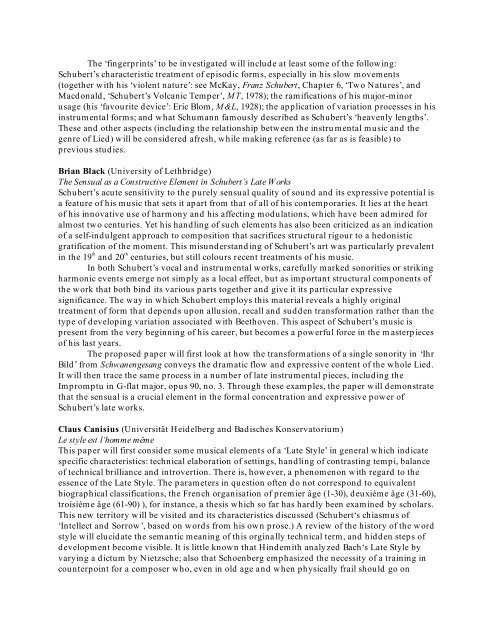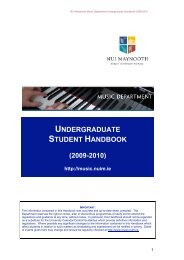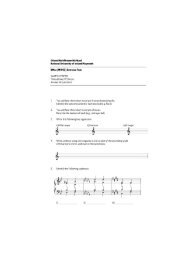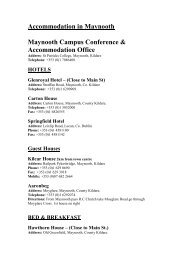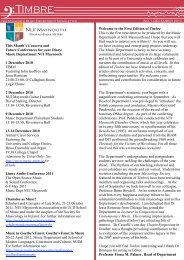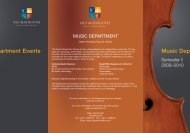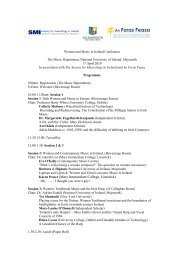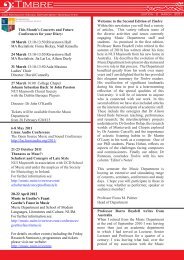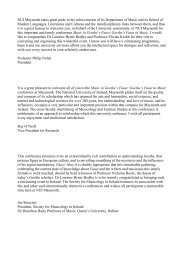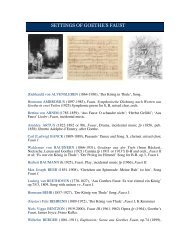Conference Booklet - Music - National University of Ireland, Maynooth
Conference Booklet - Music - National University of Ireland, Maynooth
Conference Booklet - Music - National University of Ireland, Maynooth
Create successful ePaper yourself
Turn your PDF publications into a flip-book with our unique Google optimized e-Paper software.
The ‗fingerprints‘ to be investigated will include at least some <strong>of</strong> the following:<br />
Schubert‘s characteristic treatment <strong>of</strong> episodic forms, especially in his slow movements<br />
(together with his ‗violent nature‘: see McKay, Franz Schubert, Chapter 6, ‗Two Natures‘, and<br />
Macdonald, ‗Schubert‘s Volcanic Temper‘, MT, 1978); the ramifications <strong>of</strong> his major-minor<br />
usage (his ‗favourite device‘: Eric Blom, M&L, 1928); the application <strong>of</strong> variation processes in his<br />
instrumental forms; and what Schumann famously described as Schubert‘s ‗heavenly lengths‘.<br />
These and other aspects (including the relationship between the instru mental music and the<br />
genre <strong>of</strong> Lied) will be considered afresh, while making reference (as far as is feasible) to<br />
previous studies.<br />
Brian Black (<strong>University</strong> <strong>of</strong> Lethbridge)<br />
The Sensual as a Constructive Element in Schubert’s Late Works<br />
Schubert‘s acute sensitivity to the purely sensual quality <strong>of</strong> sound and its expressive potential is<br />
a feature <strong>of</strong> his music that sets it apart from that <strong>of</strong> all <strong>of</strong> his contemporaries. It lies at the heart<br />
<strong>of</strong> his innovative use <strong>of</strong> harmony and his affecting modulations, which have been admired for<br />
almost two centuries. Yet his handling <strong>of</strong> such elements has also been criticized as an indication<br />
<strong>of</strong> a self-indulgent approach to composition that sacrifices structural rigour to a hedonistic<br />
gratification <strong>of</strong> the moment. This misunderstand ing <strong>of</strong> Schubert‘s art was particularly prevalent<br />
in the 19 th and 20 th centuries, but still colours recent treatments <strong>of</strong> his music.<br />
In both Schubert‘s vocal and instrumental works, carefully marked sonorities or striking<br />
harmonic events emerge not simply as a local effect, but as important structural components <strong>of</strong><br />
the work that both bind its various parts together and give it its particular expressive<br />
significance. The way in which Schubert employs this material reveals a highly original<br />
treatment <strong>of</strong> form that depends upon allusion, recall and sudden transformation rather than the<br />
type <strong>of</strong> developing variation associated with Beethoven. This aspect <strong>of</strong> Schubert‘s music is<br />
present from the very beginning <strong>of</strong> his career, but becomes a powerful force in the m asterpieces<br />
<strong>of</strong> his last years.<br />
The proposed paper will first look at how the transformations <strong>of</strong> a single sonority in ‗Ihr<br />
Bild‘ from Schwanengesang conveys the dramatic flow and expressive content <strong>of</strong> the whole Lied.<br />
It will then trace the same process in a number <strong>of</strong> late instrumental pieces, including the<br />
Impromptu in G-flat major, opus 90, no. 3. Through these examples, the paper will demonstrate<br />
that the sensual is a crucial element in the formal concentration and expressive power <strong>of</strong><br />
Schubert‘s late works.<br />
Claus Canisius (Universität Heidelberg and Badisches Konservatorium)<br />
Le style est l‘homme même<br />
This paper will first consider some musical elements <strong>of</strong> a ‗Late Style‘ in general which indicate<br />
specific characteristics: technical elaboration <strong>of</strong> settings, handling <strong>of</strong> contrasting tempi, balance<br />
<strong>of</strong> technical brilliance and introvertion. There is, however, a phenomenon with regard to the<br />
essence <strong>of</strong> the Late Style. The parameters in question <strong>of</strong>ten d o not correspond to equivalent<br />
biographical classifications, the French organisation <strong>of</strong> premier âge (1-30), deuxiéme âge (31-60),<br />
troisiéme âge (61-90) ), for instance, a thesis which so far has hardly been examined by scholars.<br />
This new territory will be visited and its characteristics discussed (Schubert‗s chiasmus <strong>of</strong><br />
‗Intellect and Sorrow ‘, based on words from his own prose.) A review <strong>of</strong> the history <strong>of</strong> the word<br />
style will elucidate the semantic meaning <strong>of</strong> this orginally technical term, and hidden steps <strong>of</strong><br />
development become visible. It is little known that Hindemith analyzed Bach‗s Late Style by<br />
varying a dictum by Nietzsche; also that Schoenberg emphasized the necessity <strong>of</strong> a training in<br />
counterpoint for a composer who, even in old age and when physically frail should go on


